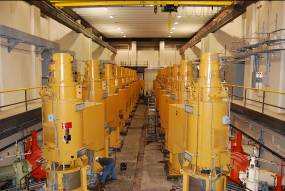Lake Mead Water Pump Failures

Figure 1. Lake Mead pump house. |
Duffner Engineering recently presented a paper at the Society for Experimental Mechanics (SEM) conference held in Jacksonville, Florida, February 1 through 4, 2010. The paper covered the failure analysis of 1000 horsepower electric drive pumps that supply the greater Las Vegas area with water from Lake Mead. The Lake Mead Pump House is shown in Figure 1.
Some of the pump risers were found to be suffering from fatigue damage and leaking in just their first year of service. The pump station had actually been in operation for many years, but had just completed a facility upgrade 1 year earlier in 2000. The pump risers are the vertical pipes that extend downward from the pump house into the lake water. Prior to the upgrade they had been set at 200 feet deep, but were shortened to 100 feet to save pumping power.
Our investigation found that the risers along with the pumps bolted to the bottom of the risers and their associated drive shafts were swinging like pendulums in their casings. The casing diameters were about 10 inches larger than the risers. Extensive testing, including strain gage, accelerometer, and ultrasonic transducer instrumentation, videography, and metallurgical and modal analysis, found that they were swinging and swaying in response to a whirlpool created at the pump suction inlet. We discovered that shortening the risers to 100 feet during the recent upgrade had actually amplified the pendulum load to above the fatigue damage threshold for the steel riser pipes resulting in premature failures.
